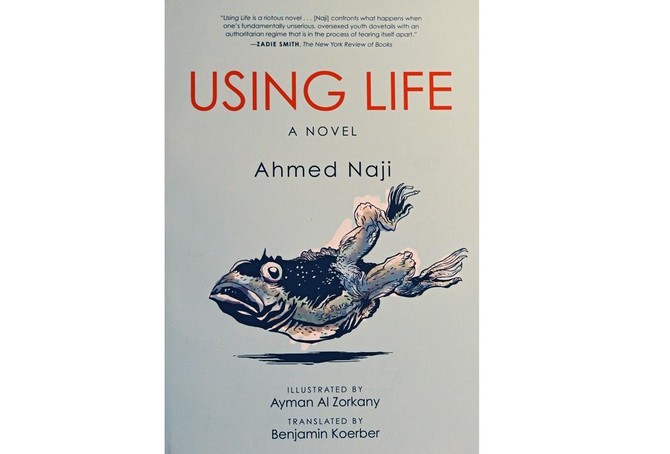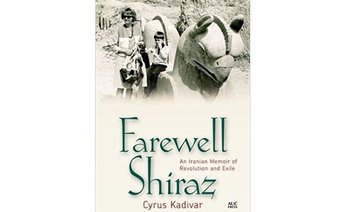“Using Life” by Ahmed Naji was first published in Arabic in 2014 and received praise throughout the Arab world. In 2016, however, Naji would be sentenced to two years in prison after a reader complained that the book “harmed public morality.” Naji’s arrest was not only a shock to him, but to the country. It was the first time in modern-day Egypt that a literary writer was imprisoned on such a charge. It took rallies and support from around the world to get Naji released at the end of 2016 and to have his conviction overturned the following year. The author of several non-fiction works, Naji is an editor and contributor at one of Egypt’s leading literary magazines, Akhbar Al-Adab, and continues to await retrial in Cairo. In the meantime, he was awarded the PEN/Barbey Freedom to Write Award for his struggles in 2016.
In 2016, Benjamin Koerber, an assistant professor at Rutgers University, translated “Using Life” from Arabic into English, introducing it to a new audience.
This is not only a unique book, it is strangely fascinating and terrifying. Naji begins the story with a storm in July, a “Tsunami of the Desert” that buries Cairo under a layer of sand. For days and nights, Cairo is blanketed by the storm; visibility is low, air conditioners are malfunctioning, traffic accidents are increasing and the heat and sand have paralyzed the city’s infrastructure. The electricity is out, communication is down and the government acts as if nothing is wrong. It is a disaster that “stretched from Nasr City in the east to the Pyramids of Giza in the west, and from Maadi in the south to the edges of Shubra in the north.” And then the earthquakes begin.
Naji’s narrative is bleak and dark, even when not meant to be. From the beginning of the book Naji introduces to the reader the idea that Cairo will be destroyed. What follows is entire neighborhoods being reduced to rubble or being swallowed whole by sink holes. The most prominent historical sites of the city are no more. “The real tragedy, however, was the millions who lost their lives, and even more, the additional millions who survived to bear the pain of loss.”
And then we meet documentary filmmaker, Bassam Baghat. He is a tainted, introspective and contemplative individual who struggles with his own happiness as he attempts to figure out where he belongs in life and in Cairo. Switching between the past, present and future, it is through Baghat that the reader sees the bleak outlook he has for Cairo. He thinks of people as a “pitiful bunch, wandering the desert under a thorny sun, imagining ourselves to be chasing after things that are actually chasing after us.”
In-between Naji’s narrative are Ayman Al-Zorkany’s illustrations that have been exhibited in Cairo and Alexandria. In the book, Al-Zorkany’s work is dark, shadowy and colorless. Each illustration has a post-apocalyptic feel to it, accompanied with a feeling of helplessness and hopelessness. His work is showcased uniquely as he is allowed the space to unfold the events of the story in his own way. His characters and scenes are detailed, but there is so much left undrawn. It is as if you see the characters, but their personalities and intentions continue to be mysterious and nefarious to the reader. The curved lines and particular eccentricities of his drawings create constant motion in the characters, which gives the reader an uneasy feeling. The illustrations, together with the dialogue, create a palpable feeling of impending doom.
Naji’s story is raw and deep. His main character is cognizant of life and how opportunity shapes life. His pessimism overwhelms his attitude and his relationships within the story. There is an added layer of suspicion and conspiracy as Naji moves on to the Society of Urbanists, a secret group that Baghat begins to work for. Baghat is to create a number of documentary films about Cairo’s architecture and its urban planning, which turns out to not be as harmless as it sounds.
The Society of Urbanists finds that Cairo has been a terrible burden on its residents. Instead of the city shaping its residents, the opposite is taking place, causing its architecture to be of little significance and more consequence. But Cairo is only one city and the Society of Urbanists have plans for cities around the globe.
With global conspiracies looming, Baghat’s observations and introspections are more meaningful. People and nature are changing the world, whether consciously or not, and the residents of Baghat’s Cairo are adapting to life as best they can. That is what they have always done. The sweltering heat does not stop the city from functioning, or stop the women in abayas from venturing outside. The billboards along the highway, the traffic, nor the stench of waste in certain areas can stop life. Baghat observes “entire neighborhoods living off electricity stolen from the lampposts along the highway” and even the disaster, the “Tsunami of the Desert,” cannot stop people from living in the city.
There is a desperation in the narrator, a nostalgia for a Cairo that has been lost for decades. It is a city that makes people miserable, as Naji writes, “for all that Cairo takes from its residents, it gives nothing in return — except, perhaps, a number of lifelong friendships that are determined more by fate than any real choice.” Naji’s characters are very specific, each inhabiting their own space in their own way. In a city of millions, no two people can be the same, as in Naji’s book.
The book is dark and questions life in a city and the function of both the city and its people. The message conveyed longs for purpose and questions what human beings think of as purposeful. It is intellectually challenging and mixed with romantic verses by Egyptian poets and lyricists, allowing the flourishing notion that futuristic urban planning can work with the historical architecture that makes Cairo the unique city that it is.
Book Review: A controversial story on storm-hit Cairo
Book Review: A controversial story on storm-hit Cairo

What We Are Reading Today: ‘The Treehouse’

- Walter excels at building tension and sustaining dread
Author: B P Walter
“The Treehouse” by B P Walter unsettles readers with a story told through the eyes of the perpetrators of a horrible crime. It follows two brothers in their 30s — Robert and Kieran — who are bound by blood, secrets, and a terrible act they committed in their youth. Their inner world is an uneasy position for the reader to inhabit, and at its best, the novel leans into that discomfort.
This 2025 psychological thriller begins with the broadcast of a television series titled “The Treehouse.” The brothers notice a resemblance between the show and their past that is impossible to ignore.
Someone knows, or seems to know, what they did all those summers ago during a family holiday in Cornwall. Someone has taken their secret and turned it into entertainment. For Robert, especially, the fear of being exposed is suffocating.
Walter excels at building tension and sustaining dread. The anxiety that coils through Robert’s thoughts is convincing, and the dynamic between the brothers becomes increasingly claustrophobic and toxic as the story unravels. It is clear that this is a family, a household, where love exists alongside something far darker.
The question of what exactly happened in the treehouse in 2004 hums beneath every chapter. Yet, despite a compelling premise and moments of real shock, the novel ultimately fell a little flat for me.
The opening is gripping, but once the story settles into the extended childhood timeline, the pacing begins to falter. The past is important, but it dominates the narrative to the point that the present-day thread, which felt sharper and more urgent with its high stakes, is left wanting.
The limited presence of secondary characters also makes it ultimately feel more predictable than it should, lacking the external conflicts that made the first act of the book so promising. The twists and turns of the final act arrive in quick succession and are less than satisfying.
This was also a difficult book to emotionally connect with; The characters are flawed, often unlikable, and while that may be intentional, it created distance rather than intrigue.
“The Treehouse” did not hold my attention in the same way as some of Walter’s previous thrillers. It’s a story that seems to linger more for the atmosphere it creates than for where it takes the reader.














